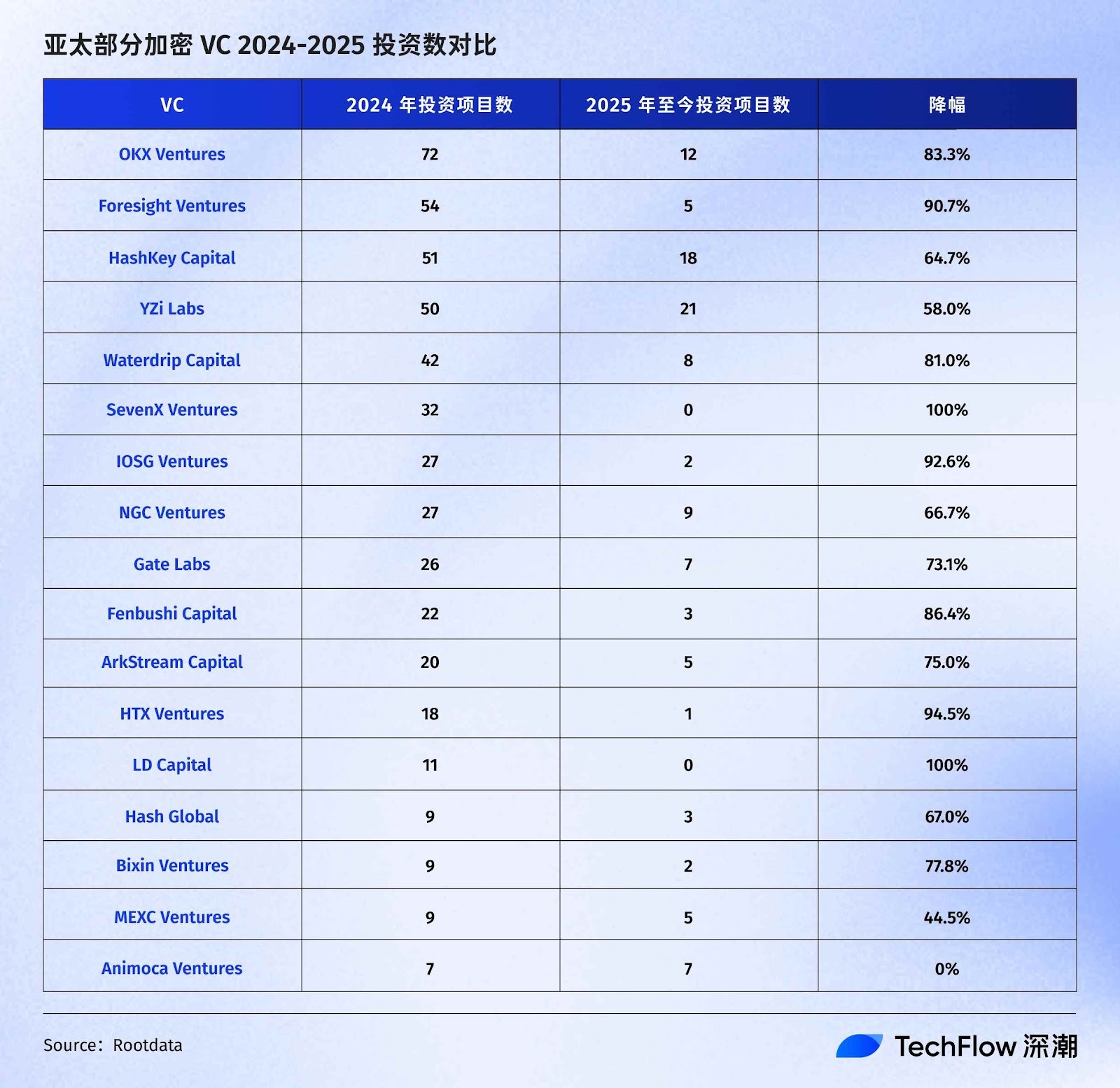Are Crypto VCs Running Out of Money?
In April 2025, the prominent crypto venture capital firm ABCDE, founded by Du Jun, announced it would halt new investments and suspend fundraising for its second fund.
The once-active investor now focuses on post-investment management and exit strategies for its portfolio, reflecting the broader reality facing crypto VCs today.
Back in 2024, we reported a wave of “rights protection” among crypto VCs. At that time, several veteran partners shifted to working with project teams or in the secondary market, all for one reason: “Being a VC isn’t profitable.”
Fast forward one year—the bull market has truly arrived.
Bitcoin remains solid above $100,000. Ethereum is back at $4,000. Stories of overnight wealth circulate regularly in the secondary market. Yet, when the spotlight shifts to the primary market, crypto VCs are struggling even more than in the previous cycle.
Criticism abounds, while profits remain elusive.
Within the crypto ecosystem, exchanges, market makers, and project teams all exert pressure on VCs.
Their investment thesis collapsed as prevailing narratives unraveled.
Fundraising is tough, and some question whether VCs add less value than KOLs.
What’s next for crypto VCs?
What Is the State of Crypto VCs?
In the last cycle, crypto VCs were known for making quick bets. They chased trending narratives, often investing in projects with no product or incomplete teams—as long as the story was compelling enough for LPs and secondary market buyers.
It was an era where “storytelling trumped product development.” But in 2024–2025, that approach has suddenly stopped working.
So, what’s happened to Asia’s once-vibrant crypto VCs?
RootData shows that, compared to 2024, the number of primary market investments by Asian crypto VCs in 2025 has plummeted.
Take the previous cycle’s most active VCs as examples: SevenX Ventures’ last disclosed deal was December 2024; Foresight Ventures dropped from 54 deals to just 5; HashKey Capital fell from 51 investments to 18.
In the 2024 Top 10 most active VCs, OKX Ventures led with 72 deals, but in 2025, that number shrank to just 12.

Jack, a partner at one VC, notes severe stratification in the sector. Smaller and mid-sized VCs are facing especially tough realities, with many forced to pivot.
His observations:
From 2023–2025, roughly 5–7% of crypto VCs shifted to marketing/KOL agency models.
About 8–10% shifted to incubation or post-investment-focused models, expanding their post-investment teams by 30–50%.
Most have shifted to the secondary market, extended fund cycles, reduced management costs, or sought compliant exit strategies such as ETF, DAT, or PIPE.
In summary, VCs now act as service providers or major “whales” within the retail investor community.
Mark, a former crypto VC investor, was blunt: “Firms doing only primary investments are basically committing suicide now.”
LD Capital has pivoted to the secondary market, with founder Yilihua now a prominent ETH strategist.
Some crypto VCs are being “forced” into AI investments.
In March, IOSG founding partner Jocy shared on social media that another portfolio project had shifted to AI. As crypto investors discover more AI entrepreneurs in their portfolios, many are making decisions with their actions.
For example, Bixin Ventures has sharply reduced crypto investments, opting for AI startups like IntelliGen AI, which focuses on AI healthcare.
While some view pivoting as a proactive response, others have simply stopped making new investments. In April 2025, ABCDE, founded by Du Jun, publicly ceased new project investments and second-round fundraising, redirecting efforts to post-investment management and exits.
“ABCDE is honest—they said they’re done. But plenty of other crypto VCs are quietly shutting down,” one VC professional commented.
With deal activity sharply down, the underlying paradigm in crypto primary markets is shifting. As Jack puts it: the shift is from “liquidity-driven narrative speculation” to “cash flow and compliance-driven infrastructure building.”
In recent years, crypto VC strategies leaned heavily on narrative. But 2024–2025 fundraising data shows an obvious turn: Pitchbook reports that Q2 2025 global crypto/blockchain VC funding totaled just $1.97 billion—a 59% drop quarter-over-quarter, and the lowest since 2020. More than half of rounds are now late-stage, meaning investors favor mature projects with proven revenue and verifiable cash flow.
“Narrative-driven early-stage fundraising is tougher; projects with genuine revenue and profits—like exchanges, stablecoin issuers, and RWA protocols—are more attractive to investors,” said Dashan, Waterdrop Capital partner.
The “listing effect” at major exchanges has also faded. Previously, listing on a top exchange guaranteed valuation liquidity. In 2025, Binance listed more tokens, but secondary market premiums have diminished. CoinGecko data shows new tokens averaged a 42% drop in the first 30 days post-TGE this year. Meanwhile, new exit routes are emerging, such as compliant ETFs, tokenized funds (DAT), protocol buybacks, and ecosystem funds as structured secondary liquidity solutions.
“The shift doesn’t mean speculation is gone—it just means speculation windows are shorter, and beta returns have given way to alpha selection,” Jack noted.
The VC Predicament
Crypto VCs’ core challenge now is simple: lack of profits.
Crypto analyst KK admits that VCs now occupy a less favorable position in the market. Projects typically lock VC tokens for one to three years, but as narratives shift rapidly, by the time tokens unlock, the hype is gone and prices plummet—sometimes even to zero. Some projects die before even listing.
Many crypto VCs also took on too many overpriced projects last cycle, and now the fundamentals can’t support those valuations.
“A lot of VCs bought into high-value overseas projects, believing bigger valuations meant stability, and co-investing with major international firms boosted their brand. But in hindsight, many of those deals lost money,” KK said.
Most crucially, crypto VCs lack bargaining power. “They essentially only bring money,” Mark said.
One interviewee put it plainly: “In this market, VC money is worth less than a Twitter KOL’s influence.”
What do projects really need?
Not just capital, but “liquidity resources.”
Market makers create secondary market depth. Exchange listings determine liquidity exits. KOLs can help projects sell tokens faster. These liquidity players often get the cheapest allocations, then flip them to VCs at much higher valuations. Crypto VCs end up investing the most but getting the worst prices.
This has created an absurd situation: crypto VCs are now the group with the least bargaining power, outmatched by exchanges, market makers, and even KOLs.
The “capital king” of the primary market has become the ecosystem’s weakest link in crypto.
The Fundraising Predicament
If “no profits” is the VC survival challenge, then “inability to raise funds” is an existential threat.
PitchBook data shows Q2 2025 global crypto VC funding at just $1.97 billion—a 59% drop quarter-over-quarter and a stark contrast to the $10 billion-plus quarters seen in 2021.
Why are traditional LPs pulling out? Beyond previous cycle losses, “making money in crypto is simply easier elsewhere,” Dashan explains. “Buying major coins, DeFi mining, options arbitrage—all yield over 30% on average. It’s tough to persuade LPs to invest in VCs, which take years to exit and usually lose money.”
Meanwhile, the investor base is shifting.
Jack observes that traditional dollar LPs are withdrawing, replaced by Middle Eastern sovereign wealth funds like Mubadala and QIA, and Asian family offices—particularly in Singapore and Hong Kong, where many use FOs and multi-strategy funds to allocate to crypto secondary and early-stage equity.
These new LPs are far more selective:
They demand real cash flows—not pitch decks. Require compliant custody, audits, and fund licenses to avoid regulatory risk. Prefer hybrid funds that combine primary and secondary strategies for near-term returns.
The brutal truth: capital is clustering among a few leaders.
“Unless you offer strong vertical differentiation or critical resources, small and mid-sized funds have a much harder time attracting LPs,” Jack said.
For native crypto VCs, fundraising is especially deadly. They must continually seek external capital but lack industry synergy to add value. VCs with exchange or market maker backgrounds, or those using proprietary capital, have both funds and resources—giving them an edge for cheap token allocations. Native crypto VCs, though, must weather this existential test.
To put it bluntly: LPs don’t lack investment opportunities—they lack certainty. Native crypto VCs, unfortunately, can’t provide it.
Where Is the Breakthrough?
Despite the grim state of the primary market, those still in the game believe this is only a period of pain—when the shakeout ends, only those left at the table will earn the rewards.
They remain optimistic about the future.
“Change breeds new opportunities,” Dashan said. “Take stablecoins: forecasts predict future issuance could exceed $3 trillion. Settlements, clearing, and compliance services around that $3 trillion will create new targets—an opportunity for crypto VCs to move early.”
The bigger narrative is just as compelling. Citi GPS 2024 projects tokenized assets reaching $10–16 trillion by 2030. Whether it’s on-chain settlement platforms or real-world asset (RWA) issuance, VCs have entry points.
“Each cycle brings new asset opportunities—trading platforms, financial derivatives, and innovative DeFi projects all keep the market dynamic,” Mark noted.
But for crypto VCs to survive, they must reinvent themselves.
They can move beyond pure financial investing by providing market-making, compliance, and liquidity support—or even getting directly involved in project operations. This model is closer to “investment banking” than traditional VC.
Alternatively, they can build structured funds using DAT, PIPE, SPAC, and other financial engineering tools, offering LPs diverse exit paths and converting “uncertain narratives” into “predictable cash flows.”
Research and data capabilities are essential—focusing on quantifiable metrics like on-chain revenue, user retention, and protocol fees, rather than betting on the next “empty narrative.”
These may be crypto VCs’ last remaining chips.
History shows that those who endure the toughest environments are the ones who last. The “weightless era” for crypto VCs may be setting the stage for the next breakout star.
Ultimately, only those still standing amid the ruins are ready for the next bull market.
Statement:
- This article is reproduced from [TechFlow] with copyright belonging to the original author [Ada, Deep Tide TechFlow]. For objections regarding this reproduction, please contact the Gate Learn team. We will process it promptly according to our procedures.
- Disclaimer: The views and opinions expressed are solely those of the author and do not constitute investment advice.
- Other language versions are translated by the Gate Learn team. Do not copy, distribute, or plagiarize translated articles without mentioning Gate.
Related Articles

The Future of Cross-Chain Bridges: Full-Chain Interoperability Becomes Inevitable, Liquidity Bridges Will Decline

Solana Need L2s And Appchains?

Sui: How are users leveraging its speed, security, & scalability?

Navigating the Zero Knowledge Landscape

What is Tronscan and How Can You Use it in 2025?


